

The built in LCD displays information depending on the state of the S.A.T. For example, the IP address, serial number and firmware version are displayed when the S.A.T. is idle. When actively tracking, the satellite name, azimuth, elevation, range and range rate and AOS/LOS is shown. Other status message are also available such as during TLE and firmware updates.
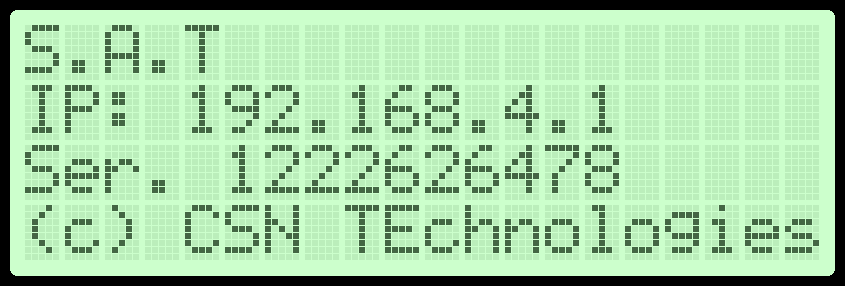

We recommend using a high quality USB wall charger to power your S.A.T. We have tested the following USB power adapter and found it to work well with the S.A.T. Get it on Amazon USB Power Supply
The S.A.T. does not need to be powered off, however if you wish to power it off we recommend using a USB cable with a built in switch like this one: USB Power Switch
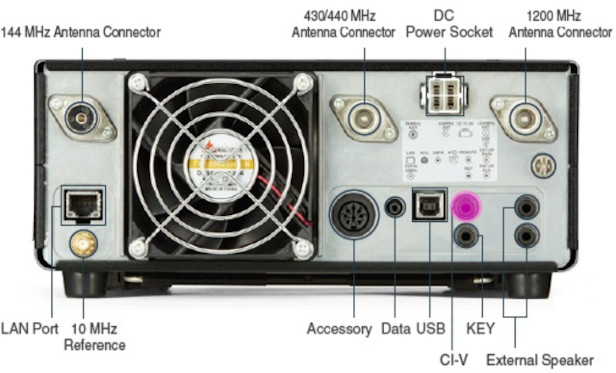
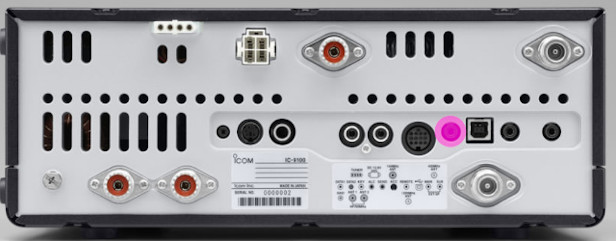
Plug the Mini-DIN connector into the S.A.T. and the full size DIN connector to the back of the rotator control box. Refer to the image for the correct port.
Do not connect the rotator until you read the calibration procedure
If the supplied DIN cable is too short for your needs, we have tested the following 8 Pin DIN extension cable: 3M DIN Extension Cable
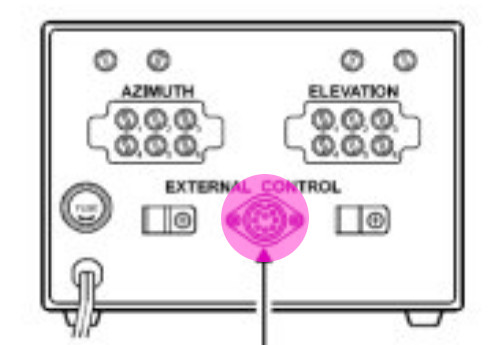
Using the provided Micro-USB cable, attached your S.A.T. to a high quality USB power adapter. The S.A.T. will immediately turn on when power is applied.
We recommend using a high quality USB wall charger to power your S.A.T. We have tested the following USB power adapter and found it to work well with the S.A.T. Get it on Amazon USB Power Supply
The S.A.T. does not need to be powered off, however if you wish to power it off we recommend using a USB cable with a built in switch like this one: USB Power Switch
Using your mobile device or WiFi enabled computer, search for available WiFi networks. Find the Access Point with the name CSN_SAT_XXXX (Where XXXX is the serial number of the S.A.T.).
Connect your mobile device to that access point. Some mobile devices will complain that this access point will not provide internet access. This is normal and you should allow the connection if prompted.
The S.A.T. dashboard will open on your device.
Click the NETWORK button at the bottom of the dashboard.
The S.A.T. will scan for available 2.4GHz networks and will display them in the dropdown box. If needed, click the REFRESH button to refresh the list.
Choose a network from the list and enter your WiFi password. Click CONNECT.
The S.A.T. will restart and attempt to connect to the selected WiFi network. Look at the LCD screen on the S.A.T. to see the IP address assigned and then connect to it using any browser on the same network.
The next step is to configure your S.A.T. Jump over to the configuration section of the manual.
If you did not purchase your S.A.T. directly from us, please register your device here: Register
Follow us on social media:
CSN Technologies Inc. provides a 3 Month LIMITED WARRANTY against manufacturing defects in materials and workmanship to the original purchaser of a new S.A.T. purchased from CSN Technologies Inc directly or from an authorized dealer. The warranty begins on the date of purchase by the customer.
During startup the S.A.T. will try to connect to a WiFi network if one has been configured. If it cannot connect to a WiFi network then it will beep twice and start its internal WiFi Access Point. In this case the LCD will display an IP address of 192.168.4.1.

Using your mobile device*, search for available WiFi network. If the S.A.T. is in Access Point mode then an access point with the name CSN_SAT_XXXX will be available. The XXXX is the serial number of the S.A.T. (older firmware versions had an access point name of Rotator_XXXX).
Connect your mobile device to that access point. (Some devices will complain that this access point will not provide internet access. This is normal and you should allow the connection if prompted.)
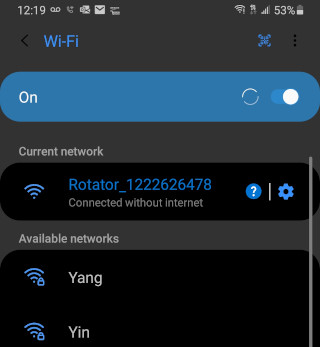
Using your mobile device's web browser, navigate to the IP address displayed on the LCD screen. For example: http://192.168.4.1
The S.A.T. dashboard will open on your device.

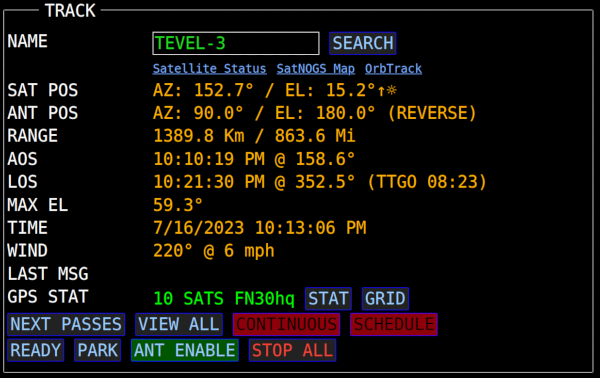
While tracking, this panel displays essential satellite information and current antenna position information. Current wind speed and direction is also displayed for your location.
Entering a satellite name or catalog number into the Name box and clicking Search will start tracking the entered satellite, if it's found in the loaded TLE file.
| NAME | Manually enter a satellite name or catalog number here and click Search to start tracking. |
| SAT POS | The current azimuth and elevation of the tracked satellite. |
| ANT POS | The current azimuth and elevation of the antenna rotator. |
| RANGE | The straight line distance to the tracked satellite. |
| AOS | The AOS time of the tracked satellite. |
| LOS | The LOS time of the tracked satellite. |
| MAX EL | The maximum elevation of the tracked satellite. |
| TIME | The current time. |
| WIND | The current wind speed and direction for your location if you have entered your OpenWeather API key in the Location settings. |
| LAST MSG | The last message received from the S.A.T. |
| GPS STAT | The current GPS status. |
| NEXT PASSES | Predict and display current and future passes. |
| VIEW ALL | View the entire set of satellites stored in the S.A.T. |
| CONTINUOUS | Continue tracking the selected satellite even after LOS. A green button indicates Continuous mode is active. A red button means Continous mode is not active. |
| SCHEDULE | Enable/Disable satellite schedule mode. See SCHEDULE section below for details. |
| READY | Move the antenna to the Ready position |
| PARK | Move the antenna to the Park position |
| ANT ENABLE | Enable or disable the rotator. Green to enable the rotator and red to disable. When disabled, no movement commands will be sent to the rotator. |
| STOP | Stop all movement and tracking |
The Satellite Status link will open the Amsat Satellite Status Page in a new window.
The SatNOGS link will open the SatNOGS map for the currently tracked satellite.
The OrbTrack link will open the OrbTrack map for the currently tracked satellite.
This is a full color map display. With this style of display you can see the satellite location above the Earth and it current track. In the lower left is a graphical display of the current antenna position.
In the bottom right of the map is a little icon that will toggle the ground track display on and off when clicked.
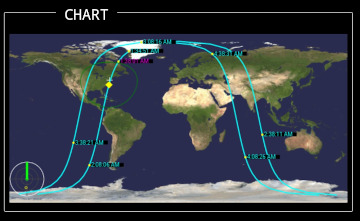
The polar view takes some getting used to but contains a lot of useful information. The outer ring is horizon and the center is directly overhead. North is towards the top. This display shows the satellite track across the sky as well as the AOS and LOS azimuth and current antenna position. The color of the track indicates if the satellite is in sunlight or shadow - yellow for sunlight and green for shadow. The antenna indicator changes color if the rotator is in flipped/reverse mode - purple for reverse and orange for normal. You can click and drag in that view to rotate the North orientation.
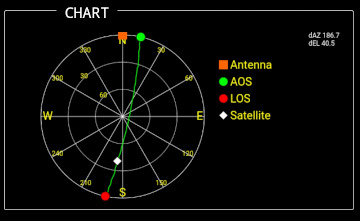
This view simulates the observer standing on the ground and looking towards the satellite's current postion. A compass is displayed along the bottom to indicate direction. With this view you can follow a satellite as is rises above the horizon and travels across the sky until it sets. The track across the sky is displayed as well as the current antenna position. The color of the track indicates if the satellite is in sunlight or shadow - yellow for sunlight and green for shadow.
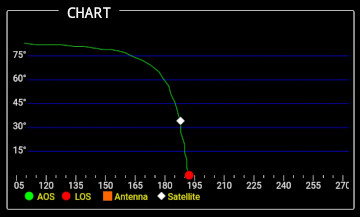

| ENABLE | Enable or disable rig control. A Green button means the rig is enabled and will be controlled. If red then it will not. |
| LOCK VFO | The S.A.T. keeps the uplink frequency in step with the downlink as you make changes with the VFO knob. Disabling this lets you tune the downlink without affecting the uplink. (Generally not needed if your radio has an RIT control). |
| CENTER | Sets the frequencies back to the transponder center frequencies. Basically resets any changes you have made by turning the dial. |
| ADD | Allows you to add a transponder that is not listed. |
| QUICK CW | Sets both VFOs to CW mode. Click to enable, click again to return modes to previous settings. |
| SDR D/L | SDR Downlink control. When green the SDR controls the downlink frequency. When red the radio controls the downlink. |
| Report Status | Choose and option to report the satellite status to other users. |
| POWER | Sets the radio power. |
| TBW | Sets the transmit bandwidth. |
| TX PL | Sets the TX PL tone. |
| MAIN | Sets the MAIN band mode. |
| SUB | Sets the SUB band mode. |
The active transponder frequency and doppler shift are displayed here.
To the right is a bandwidth indicator for transponders that have a BW setting. As you tune the VFO knob the line move left and right to indicate where you are tuned in the band. If you tune outside the BW the indicator turns red.
The available transponders for the currently tracked satellite are displayed in this area.
The currently selected transponder is highlighted in green. Click on a name to select the active transponder.
To edit a transponder's details, click on the numeric portion of the transponder entry. A transponder edit panel will open.

| CONTROL | Manually control the rotator. |
| TLE/FREQ DB | Open TLE and transponder settings |
| ROTATOR | Open Rotator settings. |
| NETWORK | Open Network & WiFi settings. |
| RADIO | Open Radio settings. |
| LOCATION | Open Location, Grid square, Callsign, Time settings. |
| CALL LOG | Open the QSO log. |
| PASS LOG | Open the satellite pass log. |
| WINDOW | Open a secondary windows. |
| SCHEDULE | Open satellite schedule window. |
| ABOUT | Open About window. Update Firmware and factory reset. |

The control panel lets you manually point your antenna to a given direction.
Enter a grid square into POINT TO LOCATION field the have the AZ automatically calculated for you. Elevation is not changed when entering a grid square.
| GO | Move to the entered position. |
| READY | Move the antenna to the Ready position. |
| PARK | Move the antenna to the Park position. |
| STOP | Stop all motion. |
| CLOSE | Close the manual control panel. |
| UP | Move elevation up. |
| DOWN | Move elevation down. |
| LEFT | Move azimuth left (counter clockwise). |
| RIGHT | Move azimuth right (clockwise). |
On the right side of the panel are four pan buttons. Press and hold the buttons to move the appropriate axis. These work similar to the physical movement button on your rotator control box. *Pan buttons may not work on mobile devices.
UP
Move elevation up.
DOWN
Move elevation down.
LEFT
Move azimuth left (counter clockwise).
RIGHT
Move azimuth right (clockwise).

It is highly recommended that you select a number of satellites as your "favorites". This will increase decrease clutter when viewing predicted passes and will improve the responsiveness of the S.A.T.
To choose your favorites, click the VIEW ALL button. You will be presented with a list of all the satellites contained in the currently loaded TLE.
Each satellite name has a checkbox next to it. Choose favorites by checking those that you want. When completed, press the SAVE FAVORITES at the bottom. A popup box will appear confirming your action.
| SELECT ALL | Check all satellites in the list. Note that if you no favorites selected then the S.A.T. acts as if all satellites are selected. |
| CLEAR SELECTION | Uncheck all satellites. |
| REPORT FOR SELECTED | Print a pass resport suitable for printing for all selected satellites. |
| SAVE FAVORITES | Save the currently selected satellites as your favorites. |
| CLOSE | Close the VIEW ALL panel. |
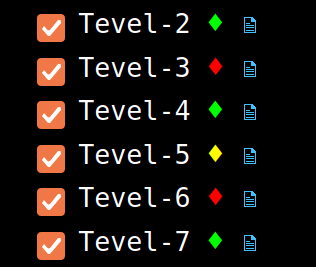
The S.A.T. includes a satellite status reporting feature that is both easy to use and informative.
In the VIEW ALL and NEXT PASSES screen you will see a colored diamond next to satellites where we have received status reports.
The color indicates the last known satellite status:
Hovering your mouse over the diamond will popup a box giving you the details about the last report such as when it was reported and what trasponder it was.
Clicking on the diamond will open a new browser page showing the history of reports for that satellite.

You can easily submit your own report. While tracking a satellite use the "Report Status" dropdown box located in the radio panel (see image above).
Simply choose one of the three status options from the choices and your report is immediatly submitted for all others to see.
We encourage you to submit reports often! All S.A.T. users benefit from the community submitting frequent and up-to-date reports.
If you make a mistake in your report, for example choosing "Active" when you meant to choose "Not Heard" - simply choose a new option and your previous selected will be replace with your new choice.
Before tracking a satellite, be sure to configure your Location, Rotator and Radio using the instructions in this manual. Also make sure your TLEs are up to date for best results.
There are a few ways to start tracking a satellite. The quickest is to type the name or catalog number into the search field and click SEARCH. The search field is not case sensitive and if you use a name it must match the name as it is in the TLE file. You can enter a partial name, for example entering "IS" would find and track "ISS". If you enter a partial name then the first matching satellite will be selected. Entering "AO-9" might find "AO-91" or "AO-92". If you know the catalog number then that is the most accurate way to search.
To track the Moon or Sun, simply type MOON (or SUN) into the seach box and click SEARCH
Another way is to click the VIEW ALL button. This will display a list off all the satellites in the loaded TLE file. Simply click a satellite name to start tracking.
Click the little report icon next to the satellite name in the 'View All' page to generate a printable pass prediction report for that individual satellite. The REPORT FOR SELECTED button at the bottom of the page will generate a pass prediction report for all satellites that have been checked. The report will be generated in chronological order.
Finally, clicking NEXT PASSES will display a list of satellites that are currently up in the sky and those that are coming up next. Those that are green are already up and the orange are currently below the horizon but they are the next to rise. The brightness of the boxes indicates the relative maximum elevation, brighter being higher. Satellites that will not rise above the MISS PASS setting in the rotator page will not be displayed. Click a satellite name to start tracking.

When tracking starts the first transponder in the list is automatically selected. Your radios VFOs and modes will be set up and the center frequencies will be selected, adjusted for doppler. Tuning will start. The calculated doppler offset and current frequency will be display in the RADIO area on the page.
Click on a transponder name to switch to it - the radio bands and modes will be automatically set for the selected transponder and frequency updates will start. If a frequency is not correct in the transponder list you can click on it and change it. The frequency you enter will be the new center frequency that the doppler shift is calculated from. The setting is not saved however you can contact us and we will make the necessary adjustment in the transponder database.
If a mode is not selected correctly you can chage it using the drop down menus. Again, contact us and we'll make corrections in the database.
The POWER and TX PL selections let you change the transmit power and transmit PL tone respectivly. Note that not all radios support changing the power levels with remote commands.
Satellite frequencies drift. This can be caused by thermal issues on the spacecraft, from satellite age and/or other factors. So some adjustment may be required by operators on on the ground. The easiest way is to use the RIT control on radios that have it (Icom 9100 & 9700). You can use the RIT control to fine tune the downlink frequency.
The other way is to simply move the tuning dial on the radio but in this case you must be aware of the LOCK VFO option on the S.A.T.
With the VFOs locked, any change you make to the downlink will also be reflected in the uplink frequency. For example, if you tune the downlink down by 5kHz, the uplink will tune up by 5kHz. Unlocking the VFO's prevents this and you are free to change the downlink without affecting the uplink.
Keep in mind some features of the radio may be difficult to manipulate while frequency updates are being sent by the S.A.T., especially if the update interval is fast (less than 1 sec). Clicking the ENABLE button will stop the updates and the button will turn red. You are now free to adjust the radio and when ready you click ENABLE to start the updates again.
| ENABLE | Enable or Disable radio updates. Green is enabled, red is disabled. When disabled you can adjust the radio without the frequency updates interfering. |
| LOCK VFO | When the VFOs are locked (Green), any change you make to the downlink will also be reflected in the uplink frequency. Unlocking the VFO's prevents this and you are free to change the downlink without affecting the uplink. |
| CENTER | Press to reset the radio to the center frequency of the transponder. |
| ADD | Add a new transponder to the currently tracked satellite. |
| QUICK CW | Switch both VFOs to CW mode. The button will turn green when active. Press again to put both VFOs back to their previous modes. |
| SDR D/L | Choose if the radio or the SDR is used to control the downlink frequency. (see the SDR section for more information) |
| Report Status | Report to the CSN server the current status of the satellite. See the VIEW ALL section for for more information. |
| PWR | Choose the transmit power level. Not all radios support this feature. |
| TBW | Choose the transmit bandwidth. Not all radios support this feature. |
| TX PL | Select transmit PL tone for FM satellites. |
| MAIN | Choose the mode of the MAIN band. |
| SUB | Choose the mode of the SUB band. |
For the easiest operation follow the steps below. This is tailored for the linear satellites but partly apply to the FM ones also.
1. Choose a satellite and transponder.
2. Tune your RIT knob on the radio until you hear your self. You should only have to move the RIT within a couple KC to find yourself. Do not touch the tuning knob until you find yourself.
3. One you can hear yourself you can then use the radio's tuning knob to work your way up and down the passband.
For best result using the RIT set your radio to not display the 1Hz digit. With the 1Hz showing you'll have rotate the RIT much more than if that digit is off. To turn the 1Hz digit off press and hold the digit for at least one second. (9700)

You can add transponders by clicking the ADD or by clicking the numeric portion of a transponder line in the list of transponders.
Either way will open the Tranponder Edit panel as shown above.
| DESCR | The transponder description. |
| FREQ UP | The uplink frequency in MHz. |
| BW | For sideband satellites, this is the bandwidth of the transponder in kHz. You can determine the bandwidth of transponders by referencing the SatNogs page. |
| MODE UP | The uplink mode. |
| PL UP | For FM satellites, this is the PL tone of the uplink. |
| FREQ DOWN | The downlink frequency in MHz. |
| RIT | The RIT setting applied automatically when the transponder is selected. For negative RIT values, enter the value as a negative number. For example, -0.600. |
| MODE DOWN | The downlink mode. |
| APPLY RIT SETTING | When checked, the RIT setting is applied automatically to all other transponders when they are selected. Ensure that only one transponder has this checked. |
| SELECT FIRST | Choose this transponder first when the satellite is tracked. |
| REMOVE TRANSPONDER | Delete this transponder. |
| SAVE | Save changes. |
| CLOSE | Close the transponder edit panel without saving changes. |
If your radio supports both VFO mode and SATELLITE mode, always use VFO mode. Do not use SATELLITE mode on your radio. For the Icom 9700, and radios that support it, display both VFOs on the screen at the same time. The red TX icon will be above the top VFO. If the red TX icon is on the bottom VFO then you are in satellite mode and you should change to VFO mode.
Some radios have a spectrum scope. If you wish to see the received signals on the scope be sure to attach the scope to the receive VFO. (See your radio's manual for instructions)
In order to use the PL Tone properly on your Icom, ensure the following setting is set to ON (DUP) (See your radio's manual for instructions)

The S.A.T. incorporates a QSO logging feature which automatically fills in all the required fields for a sucessful contact.
While tracking a satellite, press the QSO LOG button at the bottom of the S.A.T. interface to open the QSO log window as shown above.
Enter the contact callsign. If your QRZ credentials are entered in the Locations settings, you can press the LOOKUP button to automatically fill in the GRID, NAME, STATE and COUNTRY fields.
You can add a comment for the contact (see below for details on the comment field)
Finally press ADD and the QSO entry will be saved in the S.A.T. and will also be displayed in the main window in the QSO Log list near the bottom of the screen.
The QSO log can be downloaded from the S.A.T. in ADIF format. The ADIF file will contain fields that you do not need to complete since the S.A.T. knows what they are and will fill them in for you. Field such as satellite name, uplink and downlink frequencies, modes and location are all automatically completed for you.
The S.A.T. can send QSO log entries to your favorite logging program at the moment they are added. Choose your logging program and associated settings in the Location panel. Instruction for the support logging programs can be found in the Third Party Interfaces section of this manual.
| CALLSIGN | Contact callsign. |
| GRID | Contact grid square. |
| NAME | Contact name. |
| STATE | Contact state. |
| COUNTRY | Contact country. |
| RST SENT | RST Sent |
| RST RECV | RST Received |
| COMMENT | Log comment. |
| LOOKUP | Press to lookup callsign in the QRZ.com database. |
| ADD ENTRY | Save QSO entry to log. |
| CLEAR ENTRY | Clear the current entry fields. |
| DOWNLOAD LOG | Download the QSO log in ADIF format. |
| DELETE LOG | Delete the entire QSO log from the S.A.T. |
| CLOSE | Close the QSO log window. |
The comment field supports macro variables that change according to the current state of the S.A.T.
For example, if you wanted to have the comment say "Thank you for the contact on RS-44" but have RS-44 always be the current satellite that your are tracking, the your would enter "Thank you for the contact on $s"
The S.A.T. will replace the following variables according to the list below:
| $m | My callsign as it's entered in the Location settings |
| $c | The contact callsign. |
| $n | The contact name. |
| $s | The satellite name |
The QSO log of the S.A.T. is intended to make it easy to add satellite contacts and is not a full featured logging program.
You should download the QSO frequently and import into your favorite logging program and delete the log from the S.A.T.
The S.A.T. is limited to storing a maximum of 100 QSO log entries. Once filled, new entries cannot be added.
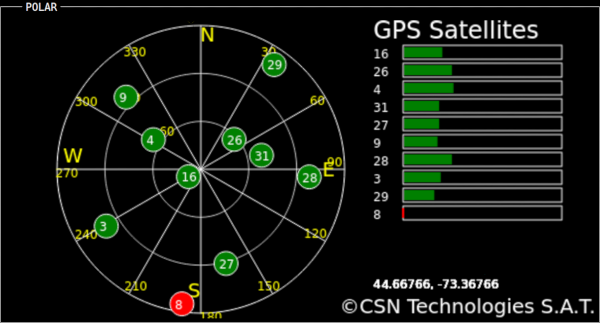
The S.A.T. contains a built in GPS to provide you with the highest level of positional accuracy. It also makes it easier when roaming since you do not need to change your location setting when you move from place to place.
The TRACK panel in the main interface indicates the current status of the GPS by displaying the number of GPS satellites acquired and the current gris square.
The status line is red when the GPS does not have a lock. Green when it is locked. Yellow when it locked but is not being used because it's disabled in the Location settings.
If the GPS is Enable in the Location panel but is does not yet have a lock, then the position you have saved are used.
The STAT toggle the polar view from normal satellite view to GPS satellite view (shown above). The GPS satellite view shows the position of the GPS satellites in the sky and your current latitude and longitude.
The GRID toggles GPS GRID mode. This is used for roaming and changes the LCD screen on the S.A.T. to display the current grid square, time and exact coordinates. In this mode, the S.A.T. will beep as as you cross grid boundaries. This mode can be started automatically by choosing "Enable w/ Auto Grid Mode" in the Location settings. If option is selected the the S.A.T. will enter GPS Grid mode automatically about 2 minutes after it boots. In this way, you do not need to connect to the S.A.T. to press the GRID button to turn on GPS Grid mode.
The GPS antenna is built into the S.A.T. The ability to acquire a lock is of course dependent on the environmental conditions that the S.A.T. is in. It naturally works best outside with a clear view of the sky. We have found that it also works well inside homes and buildings. It may take a long time to acquire a lock in poor conditions. If you cannot acquire a lock, make sure that your postion is set in the Location settings.

You can schedule the satellites that you want to track. For example if you want to collect APRS packets from every pass of the ISS, even when you're not present, you can do that here.
Choose a satellite and a transponder from the dropdown lists and click the ADD button. You can add any number of satellites this way. To remove a satellite, click the red X next to the name.
To enable the schedule, press the SCHEDULE button in the TRACK panel. A green button means the schedule is active and if red then it is not active.
With the schedule enabled the S.A.T. will track all the satellites in list in the order of AOS. Tracking starts about 60 seconds before AOS.
A satellite that is currently being tracked will never be interrupted by a scheduled satellite. So if you are manually tracking when a schedule pass is approaching your currently tracked satellite will not be stopped.
Also, when two scheduled satellites overlap in time, the one with the earlier AOS will be tracked first and all the way to LOS before the next satellite in the schedule is selected and tracked.
| ADD SAT | Add the currently selected satellite and transponder to the schedule. |
| CLEAR | Remove all satellites from the schedule. |
| LOAD | Load the saved schedule. |
| SAVE | Save the current schedule. |
| CLOSE | Close the window. |
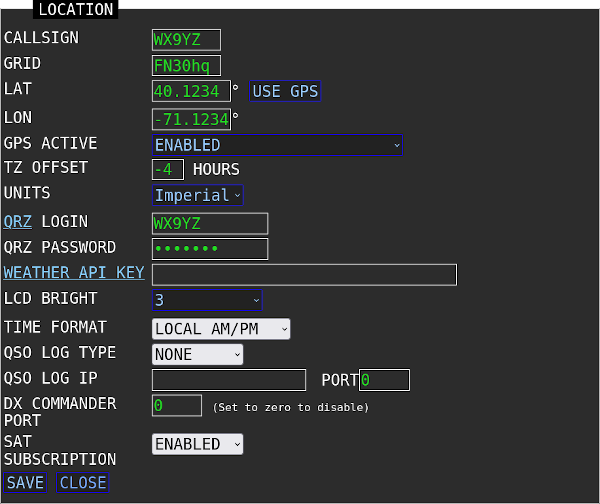
| CALLSIGN | Enter your callsign here to be used in the QSO logging feature. |
| GRID | Enter your gridsquare to automatically calculate your latitude and longitude. It's also used the the QSO logging feature. |
| LAT,LON | Enter your precise latitude and longitude. |
| USE GPS | Use the GPS to automatically fill in the Grid and location fields. GPS lock required |
| GPS ACTIVE | Enable the GPS for satellite tracking. |
| TZ OFFSET | Enter your timezone offset from UTC in hours. |
| UNITS | Choose to display Imperial or Metric units. |
| QRZ LOGIN | Enter your QRZ.com login name (optional, used for the Call Log lookup feature) |
| QRZ PASSWORD | Enter your QRZ.com password |
| WEATHER API KEY | Enter your OpenWeatherMap account key (optional). Create a free account at OpenWeatherMap to obtain a key. |
| LCD BRIGHT | Adjust the brightness of the LCD screen. (For compatable units) |
| TIME FORMAT | Choose your preferred time display format. |
| QSO LOG TYPE | For automatic QSO log entry, choose your log software. See the Third Party Interfaces section below for instructions on configuring each log type. |
| QSO LOG IP | Enter the IP and PORT where the log software is running. |
| DX COMMANDER PORT | Enter a port here if using DX Commander. (Must be using DX Keeper as a log type) |
| SAT SUBSCRIPTION | Enable or Disable your S.A.T. subscription if you have purchased one. |
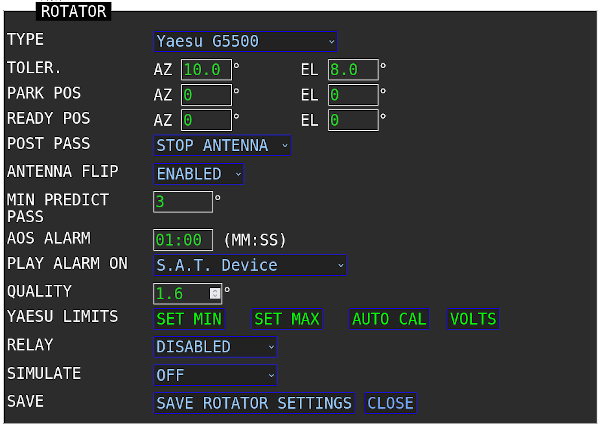
The Rotator Panel is where you will find the rotator and satellite tracking settings.
| TYPE | Choose the rotator model to use. The S.A.T. natively supports the Yaesu G5500, G5400 and G5600 with the included cable. PstRotator is also supported. |
| IP ADDRESS | For PstRotator enter the IP address of the computer where PstRotator is running. PstRotator needs to be configured to accept UDP packets. In the PstRotator "Communication" menu choose "UDP Control Port." You can accept the default IP address and port in displayed in this window. If the settings are blank the click the "By Default" button. Click "Save Settings" to close the window. Finally, under the Settings menu in PstRotator, click "UDP Control" to allow remote control. Once configured properly, PstRotator will send feedback to your S.A.T. letting it know the antenna's current position. If you do not see the correct antenna postion displayed in the S.A.T., you may need to allow UDP port 12000 through your computer's firewall. |
| TOLERANCE | The S.A.T. tracks in such a way that when it moves the antenna it moves ahead of the satellite. This causes the satellite to pass directly in front of the antenna as the satellite moves across the sky and prevents the antenna from always having to "catch up" to the satellite. The TOLERANCE sets this window of movement. For example, with a setting of 10° for azimuth, when the satellite moves ahead of the antenna by 5° the antenna will move 5° ahead of the satellite. Then the satellite will then pass pass directly in front of the antenna and when it leads by 5° again, the antenna will move 5° ahead of it again. Same for elevation. |
| PARK POS | The position the antenna should move to when the Park button is pressed. |
| READY POS | The position the antenna should move to when the Ready button is pressed. For the fastest response when tracking, a Park position of 180° azimuth and 90° elevation should be used. |
| POST PASS | Choose how the antenna should be positioned at the end of a pass. You can choose to move to the Park or Ready position or no movement. Be aware this option may stress your rotator beyond the duty cycle limits specified in you rotator user manual. |
| POST PASS | Choose how the antenna should be positioned at the end of a pass. You can choose to move to the Park or Ready position or no movement. Be aware this option may stress your rotator beyond the duty cycle limits specified in you rotator user manual. |
| ANTENNA FLIP | Enable or Disable the antenna flip feature. With this setting enabled, the S.A.T. will automatically flip the antenna over when a satellite path passes though north so there is no time lost during the tracking. (On the G5400 and G5600 the S.A.T. will flip the antenna if a satellite passes through south.) |
| ALARM | The S.A.T. contains a built in beeper that will sound when the satellite reaches a set amount of time prior to AOS. Enter the minutes and seconds here at which time you would like to hear the alarm. Enter 00:00 to disable the alarm. |
| PLAY ALARM ON | The AOS alarm can be sounded on the S.A.T. using built in beeper, in the web browser or both. Note that not all web browers are supported. |
| QUALITY | This is a quality setting for the angle sense potentiometer in the rotator housing. If you hear excessive relay clicking in your rotator box you can slowly increase this value. A higher value reduces the resolution when the antenna is commanded to a particular position. For example if the setting is 2° here and the antenna is commanded to 100° it may stop anywhere between 98° and 102°. |
| YAESU LIMITS | (See the calibration procedure) |
| RELAY | Enable the build in relay. Your S.A.T. has a three terminal relay jack. The center is common and the right and left sides are NO and NC respectively. When the relay option is enabled, the relay closes when the satellite reaches 3° below the horizon just before AOS and stays closed until LOS. Relay is rated 24 VAC, 2 Amps, total 48 Watts. |
| SIMULATE | If no antenna is connected then checking this option simulates one and the information panels and maps display where the would be if it was connected. |
| SAVE | Save and close the Rotator Panel |
Before attaching your S.A.T. to your rotator, manually set the azimuth and elevation to their minimums. On the G5500 this is 0° AZ and 0° EL, on the G5400 this is 180° AZ with the needle to the left and 0° EL. You can now attach the S.A.T. to your rotator using the supplied DIN cable.
Once connected, open the ROTATOR PANEL in the Dashboard.
Your S.A.T. will swing the antenna rotator through it's full rotations in both Azimuth and Elevation to detect the limits. Make sure your rotator is ready to move through the full rotation and nothing is obstructing it's motion such as short wires, tree branches, etc. Once the calibration is started the only way to stop it is to remove power from the S.A.T.
Press the AUTO CAL button in the opened ROTATOR PANEL. When you press OK on the warning box the rotator will start moving. This can take up to four minutes. While it's calibrating you can watch the guages on the Yaesu control box. When it's complete a box will notify you that the calibration is complete. You can skip the Manual Calibration below.
If, however, a box opens and indicates that voltages were exceeded then please follow the Manual Calibration procedure below.
*Note: Not all rotator choices support auto-calibration.
Click on the VOLTS button (You can close the message that opens, it's just a reminder of these instructions). The sensed voltage from the rotator control box is now displayed on the LCD.
Manually increase your azimuth and watch the voltage on the LCD. The first number on the top line is the voltage for azimuth. Stop moving if this voltage goes higher than 5 volts! If it passes 5 volts then you need to turn the Output Voltage Adjustment knob on the back of your rotator control box to decrease it. See your Yaesu Manual for instructions.
The goal is to increase the AZ to it's maximum and adjust the voltage to keep it between 4 and 5 volts. The maximum azimuth for the G5500 is the red 90° mark on the right side of the guage, on the G5400 the maximum is the 180° on the right of the guage. If the voltage ends up below 4 volts then for highest accuracy you should increase it by turning the Output Voltage Adjustment on the back of your rotator control box. When the voltage is between 4 and 5 volts at the maximum azimuth then you can move on to the elevation setting.
The elevation is set the same way as the azimuth. Increase the elevation and watch the LCD to make sure it does not pass 5 volts. Again adjust the voltage to get it between 4 and 5 volts at the maximum elevation (180° on both the G5400 and G5500). *If your G5500 is limited to only 90 degrees elevation then choose "Yaesu G5500 360/90" in the rotator selection. Then during the manual calibration you can move the elevation to 90 degrees instead of the full 180.
Finally, when the both azimuth and elevation are at their maximum positions and the voltages are between 4 and 5 volts, press the SET MAX button.
Now move both AZ and El all the way back to the minimums. Press the SET MIN button.
Your S.A.T. is now calibrated to your rotator control box. Press the STOP button to exit Voltage mode. You need to do this calibration process every time the S.A.T. boots. Just kidding! *The calibration only has to be done once ;).
If anything changes in your rotator configuration, such as changing the rotator cables, you should calibrate the S.A.T. again.
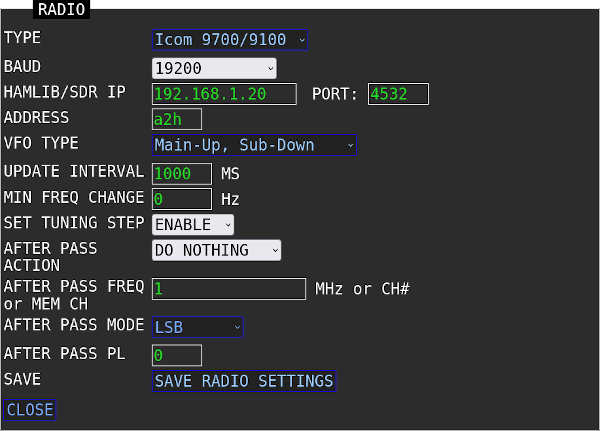
Configure your Radio in this panel
| TYPE | Choose the type of radio to control. The S.A.T. works best with the Icom satellite radios - 9700, 9100, 910, 820 and 821. It will work with other Icom radios but your results will be limited since they are not full duplex. The Icom 705 is not supported since it does not have a CI-V port. |
| BAUD | Select the baud rate of your radio. This must match the baud rate setting on your radio. 19200 baud is recommended for radios that support it. |
| HAMLIB/SDR IP | Enter the IP address and port of a SDR program that supports Hamlib control. Leave blank to disable. |
| ADDRESS | Enter the CI-V hexadecimal address of your radio. The Icom 9700 default address is A2h. |
| VFO TYPE | The VFO type of your radio. The Icom 9700 is Main-Up / Sub-Down. * Do not enable Satellite Mode on the Icom 9700 |
| UPDATE INTERVAL | How often to send frequency updates to the radio. (In milliseconds) |
| MIN FREQ CHANGE | Minimum doppler correction in Hz before sending frequency updates to the radio. (Overrides update interval) |
| AFTER PASS ACTION | Choose what you want your radio to do after a satellite pass. Options are Do nothing, Restore VFO which returns the state of the VFO to what it was prior to tracking, Set Freq, or choose a memory or calling channel. |
| AFTER PASS FREQ OR MEM CH | If you choose Set Freq above, enter the full frequency here. If you choose Set Mem Ch# above then enter the memory channel here. |
| AFTER PASS MODE | If setting a frequency, you can also set the mode. |
| AFTER PASS PL | If setting a frequency, you can also set a PL tone. |
| SAVE | Save and close the Radio Panel |
S.A.T. Settings:
In the Icom, be sure to set:
S.A.T. Settings:
In the Icom, be sure to set:
* Note that the SAT will utilize memory channel 99 if you choose 'Restore VFO' in the After Pass option. Any contents in memory channel 99 will be overwritten.
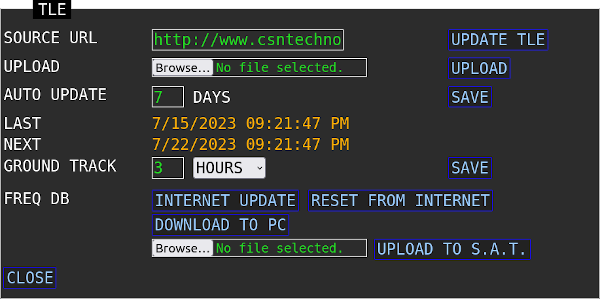
The TLE Panel is where you set various TLE options.
| SOURCE URL | Provide an internet address of the TLE to download. Note that the S.A.T. does not support https:// addresses. You can usually simply remove the 's' from https and it will work but it depends on the server that you are connecting to. Click UPDATE NOW to update. Note that an internet connection is requires to update. Default setting: http://www.csntechnologies.net/SAT/csnbare.txt |
| UPLOAD | Use this option to upload a custom TLE file. This file will replace the TLEs that are stored in the SAT. The uploaded TLE file should be in the standard format and must not contain any header lines. |
| AUTO UPDATE | How often to automatically update the TLEs from the SOURCE URL. Enter zero to disable auto-updates. (Click SAVE to save setting) Default setting: 7 days |
| LAST | The date and time of the last TLE update. |
| NEXT | The date and time of the next scheduled update if AUTO UPDATE has been set. |
| GROUND TRACK | How many hours or orbits of ground track should be shown on the maps. (Click SAVE to save setting) Default setting: 3 hours |
| FREQ DB | Options for refreshing the transponder database. |
| INTERNET UPDATE | Updates the transponder data while preserving changes you have made. |
| RESET FROM INTERNET | Factory resets the transponder database. Changes you have made will be lost. |
| DOWNLOAD TO PC | Downloads a text file of the transponders to your PC. We suggest you back up your frequency file to your PC after you make transponder changes. |
| UPLOAD TO SAT | Lets you choose a transponder file and upload it to the SAT. |
| CLOSE | Close the TLE/FREQ DB Panel |
If you do not see any freqencies when you track a satellite please open the TLE/FREQ DB panel and click the 'RESET FROM INTERNET' button. This will load the frequency database.
CSN Technologies maintains a customized TLE source specifically targeted to Amateur Satellite use. The TLE data is refreshed daily and new satellites are added as soon as we have TLE data for them.
The URL for the CSN TLE is:
http://www.csntechnologies.net/SAT/csnbare.txt
The satellite names in the CSN TLE file follow the AMSAT naming conventions.
We recommend you schedule TLE updates to occur every 7 days. While our TLE file is refreshed daily, the actual TLE data inside the file may be older. TLE data for individual satellites is updated on their own schedules which vary from daily (ISS) to weeks.
Note that AMSAT updates their popular nasabare.txt TLE file weekly.

* This section describes the Network Settings panel. For more information regarding the access point on the S.A.T., see the Network Setup page in the Get Started section
The visible 2.4GHz WiFi points will be available in the dropdown box. If needed, click the REFRESH button to refresh the list. If you want to connect to a hidden WiFi network, please see the "Common Questions" section at the bottom of the page. Use the WiFi AP select box to choose an Access Point. Enter your WiFi password and click CONNECT. The S.A.T. will restart and attempt to connect to the WiFi network. Look at the LCD to see the IP address obtained and then connect to it using your mobile devices. Once connected you can update the TLEs and perform firmware updates.
| REFRESH | Refresh the Access Point dropdown list. |
| CONNECT | Connect to the selected Access Point. |
| CLOSE | Closed the Network Panel. |
| FORGET NETWORK | Disconnect and forget the currently connection WiFi network. The S.A.T. will reboot into Access Point Mode |
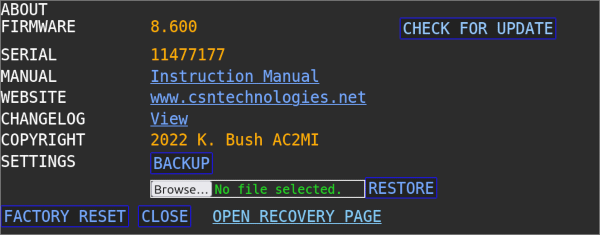
The About panel display firmware versions and copyright information.
| FIRMWARE | Displays current firmware version. |
| SERIAL | Displays S.A.T. serial number. |
| MANUAL | Link to the S.A.T. Online Manual |
| CHANGELOG | Link to the S.A.T. Firmware Changelog |
| COPYRIGHT | Copyright Information |
| BACKUP | Download a copy of the S.A.T. configuration settings. |
| RESTORE | After choosing a settings file to restore, click this button to upload the settings. |
| FACTORY RESET | Factory Reset the S.A.T. |
| OPEN RECOVERY PAGE | May be used in special cases by tech support. |
| CLOSE | Close the About Box |
The S.A.T. can be configured to send the downlink frequency and mode to a compatable SDR programs.
The requirement is your SDR program must be able to be controlled over the network using Hamlib commands. Two programs tested are SDR Angel and Gqrx.
Other SDR programs may work. Check the documention of your program to see how to set it up.
Configure SDR Angel
Configure Gqrx
To enable SDR control in the S.A.T., simply open the Radio Settings panel and enter the IP address of the computer running the SDR program.
It's recommended to use port 4532 for SDR control. This port number must match the port number configured in the SDR program.
SDR support is independant of what type of physical radio you are using. If the IP address and port are set, the S.A.T. will try to connect to the SDR program when you track a satellite and each time you change transponders.
However, if you do not have a physical radio and you are only using an SDR, then select Hamlib/SDR as the radio.
When using an SDR, a new button will appear in the radio section of the S.A.T.
This button lets the S.A.T. know which receiver is controlling the downlink frequency. Normally, without an SDR, you tune your radio with the VFO knob and the S.A.T. will adjust accordingly. If you enable this button while using an SDR, you can tune with the SDR program and the S.A.T. will adjust accordingly with the new SDR frequency instead of the radio.
To disable SDR support in the S.A.T. you only need to set the port to zero. The IP address can be left in the box. The S.A.T. will not try to connect to a SDR program if the port is zero.
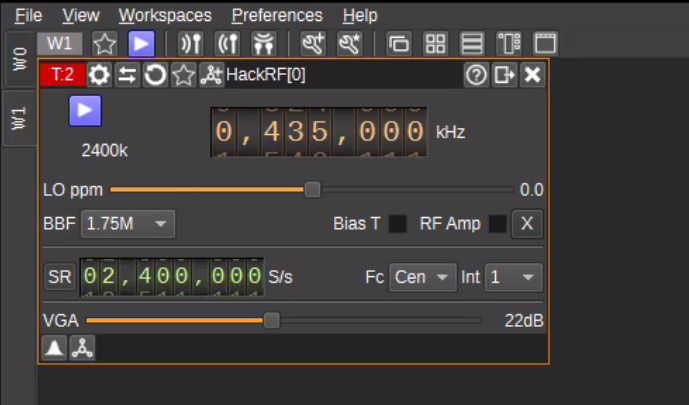
Click the Add Feature button  to open the Add Feature dialog. Select RigCtl Server and click the Apply button. Click Close to close the Add Feature dialog.
to open the Add Feature dialog. Select RigCtl Server and click the Apply button. Click Close to close the Add Feature dialog.
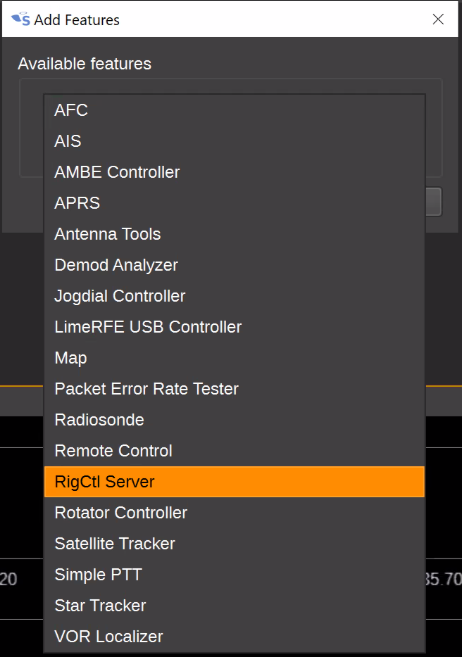
The RigCtl Server window should be displayed:

Select your device and channel in the RigCtl settings. You must already have a channel active in order to use RigCtl. It doesn't matter what mode of channel you select since the S.A.T. will send the command to change it.
Click the blue Play button to start the RigCtl Server.
SDR Angel should now respond to frequency and mode commands sent by the S.A.T.
To configure Gqrx you will need to add the IP address of the S.A.T. into the network setting panel.
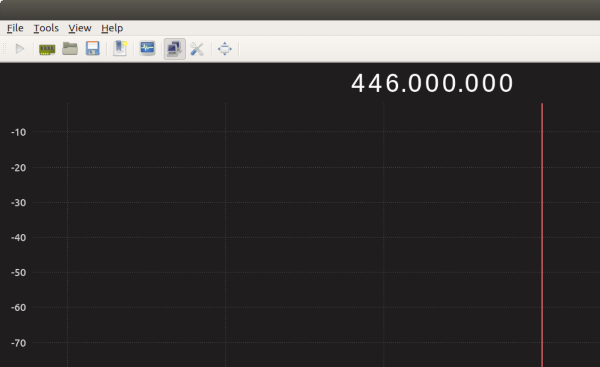
In the Tools Menu - click Remote control settings to open the network setting panel:
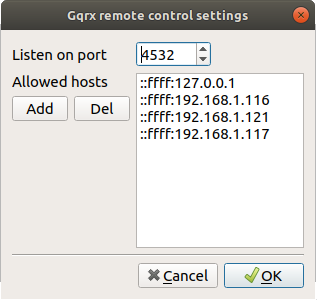
Click the Button to add a new entry in the list on the right. Here you will enter the IP address of the S.A.T.
The IP address must be entered in a very specific way. For example, if the IP address of your S.A.T. is 192.168.1.123 it must be entered list this:
::ffff:192.168.1.123
We recommend using 4532 for the port number since it is the customary one used for Hamlib radio control. However, you can choose any port you like so long as it matches the port number set in the S.A.T.
Ensure that port you have selected is not blocked by your computers firewall. You may need to add an exception for it.
Click OK to save the settings.
Once the settings are saved, you enable remote control in the Tools Menu and selecting Remote control
Gqrx should now respond to frequency and mode commands sent by the S.A.T.
You can quickly enable and disable the network control in Gqrx by using the buttons instead of the menu:
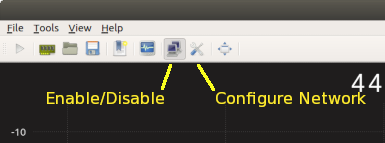
The S.A.T. will broadcast a UDP packet on port 9932 when certain events occur.
The data format is a comma seperate string each of which is described below. All packets starts with the text "SAT" and the name of the event. Each packet ends with a newline character (\n).
| BOOT | Broadcast when the S.A.T. is power up.
Format: SAT,BOOT,SERIAL,VERSION
SAT,BOOT,1147717711,8.600 |
| START TRACK | Broadcast when the S.A.T. starts to track a satellite.
Format: SAT,START TRACK,NAME,CATNO
SAT,START TRACK,LEDSAT,49069 |
| AOS | Broadcast when the tracked satellite reaches AOS
Format: SAT,AOS,AZ
SAT,AOS,27.1 |
| LOS | Broadcast when the tracked satellite reaches LOS
Format: SAT,LOS,AZ
SAT,LOS,174.9 |
| TRANSPONDER | Broadcast when a transponder is selected.
Format: SAT,TRANSPONDER,NAME,UPFREQ,UPMODE,DOWNFREQ,DOWNMODE
SAT,TRANSPONDER,1200 Baud Data,435310000,USB-D,435190000,USB-D |
| STOP | Broadcast when a S.A.T. stops tracking a satellite.
Format: SAT,STOP Example: SAT,STOP |
| QSO | Broadcast when a QSO log entry is added
Format: SAT,TRANSPONDER,SATNAME,CALL,GRID,MODE,COMMENT,RSTSENT,RSTRECV,UPFREQ,DOWNFREQ,NAME
SAT,QSO,LEDSAT,KC2SYF,fn30ha,PKT,Thanks!,59,59,435.311036,435.188964,Mike |
If there are spaces or punctuation in the SSID or password then it must be URL encoded first. Click here for an online encoding calculator.
Example:
The hidden network name is My Hidden_Network! and the password is My#$%Password.
The SSID gets encoded to My+Hidden_Network%21
The password gets encoded to My%23%24%25Password
The complete URL encoded string would then be:
http://192.168.4.1/?a=W|My+Hidden_Network%21|My%23%24%25Password